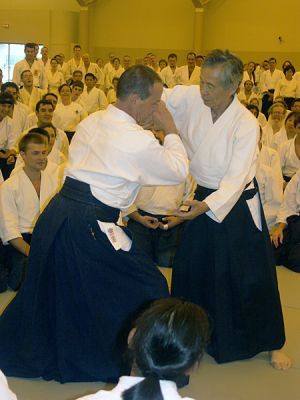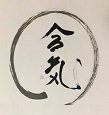Chapter 6 - Relations with other Martial Arts

Brought Aikido to France and US
Aiki (as distinct from Aikido) is the origin of all martial arts. This is what the Founder of Aikido wished to express when he named his art takemusuaiki.
However, it is important to note that the primordial nature of Aiki doesn't imply that Aikido is the best martial art, but only that it is one way towards aiki. Being able to develop the multiple facets of Aikido requires one to integrate the principle of Aiki.
Aiki consists in uniting oneself with the ki of the heavens and the earth. Aiki is not exclusive to budo but is part of all human activity. Applying the principle of Aikido to events will help us understand them better; acting in accord with this principle will make our actions easier.
This principle applies to daily life, to social relations and to modern science.
Bujutsu and Budo were created by men who lived on the edge of life and death. Driven by an unshakable will, such men built up layers of experience, invoked the gods and prayed beneath waterfalls.
Bujutsu and Budo are not merely techniques. Their value comes from using asceticism to go beyond technique. The techniques originated from the specific circumstances of their creator's life: the place, the era, the human situation. Thus if you are given a chance, widen your horizons and practice or watch techniques anytime an occasion presents itself.
Compare and see what you can integrate in your own practice of Aikido. But beware; the idea is not to copy the other arts nor to mix them together!
Chapter 8 - Beginners
Accepting New Students
When a new student comes to enroll in the dojo, the teacher should study his or her face, language, attitude and appearance. The teacher should also find out why the new student wishes to practice Aikido, whether he intends to practice for a long time and regularly and determine whether he or she will integrate well with the other students.
It seems to me more than desirable to make at least such a cursory examination before accepting a new student.
Accepting as a student anyone who shows up at the dojo only because he or she pays his dues reflects a narrow-minded attitude. Moreover, it is disquieting that someone who bears the responsibility to guide others in the "way" would be so oriented and would behave in such a fashion.
Introduction and Etiquette
Before entering the dojo, a beginner should be shown how to wear a gi and hakama, and how to fold them. The beginner should also be taught how to behave when entering or leaving the dojo, and how to bow to the teacher, the sempais and his partners. It is important that the teacher introduces the newcomer to the other students. It is only after a student has been introduced to the other members of the dojo that he or she should be considered as a student in good standing of the dojo.
Today it is often the dojo secretary who is responsible for controlling admissions. And yet the secretary should only be responsible for administrative issues. The decision-making power should be in the hands of the teacher -- at least in matters regarding teaching. Practicing budo is impossible in a dojo where beginners get on the mat without first introducing themselves to the teacher, and where more senior students allow this to happen as if it didn't concern them.
Beginning Training
Beginners should start learning Aikido through basic practice such as tai no henko, ukemi, etc.
In order that they come to understand the nature and meaning of Aikido, beginners should be handled with patience, kindness, attention and precision. This will progressively bring them to a more intense level of practice.
At first, beginners feel lost and don't know what to do. The teacher's role is to avoid this situation. A beginner who is sitting alone on the side of the mat without a partner is proof that the education of the older students in the dojo is lacking.
If this situation occurs, it indicates that the dojo members lack awareness regarding how to maintain a general harmony among human beings during practice. They are not sensitive to the feelings of others. The teacher must strive to create a working atmosphere of mutual respect and harmony so that the students to are highly attentive and behave in this way even when the teacher is absent. This education must take place on a daily basis.
In fact, such an atmosphere should be established without explicit intervention. Everyone should know these rules and put them into practice. Beginners will then effortlessly be integrated, thanks to the atmosphere in the dojo.
